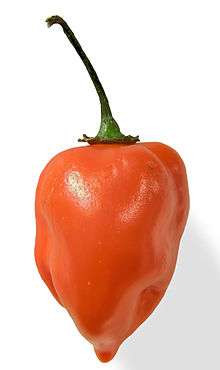Scoville scale
The Scoville scale is a measurement of the pungency (spiciness or "heat") of chili peppers, as recorded in Scoville Heat Units (SHU), based on the concentration of capsaicinoids, among which capsaicin is the predominant component.[3][4][5][6][7] The scale is named after its creator, American pharmacist Wilbur Scoville, whose 1912 method is known as the Scoville organoleptic test.[3][8] The Scoville organoleptic test is the most practical method for estimating SHU and is a subjective assessment derived from the capsaicinoid sensitivity by people experienced with eating hot chilis.[3][4]
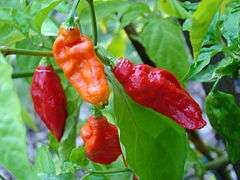
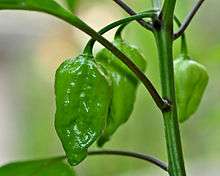
An alternative method, using high-performance liquid chromatography (HPLC), can be used to analytically quantify the capsaicinoid content as an indicator of pungency.[3][5][7] As of 2011, the subjective organoleptic test has been largely superseded by analytical methods such as HPLC.[9]
Scoville organoleptic test
In the Scoville organoleptic test, an exact weight of dried pepper is dissolved in alcohol to extract the heat components (capsaicinoids), then diluted in a solution of sugar water.[3][10][11] Decreasing concentrations of the extracted capsaicinoids are given to a panel of five trained tasters, until a majority (at least three) can no longer detect the heat in a dilution.[1][3][10][11] The heat level is based on this dilution, rated in multiples of 100 SHU.[10]
Another source using subjective assessment stated: "Conventional methods used in determining the level of pungency or capsaicin concentration are using a panel of tasters (Scoville Organoleptic test method). ... Pepper pungency is measured in Scoville Heat Units (SHU). This measurement is the highest dilution of a chili pepper extract at which heat can be detected by a taste panel."[4][12]
A weakness of the Scoville organoleptic test is its imprecision due to human subjectivity, depending on the taster's palate and number of mouth heat receptors, which vary widely among people.[1][4] Another weakness is sensory fatigue;[1] the palate is quickly desensitized to capsaicinoids after tasting a few samples within a short time period.[10] Results vary widely (up to ± 50%) between laboratories.[11]
Pungency units
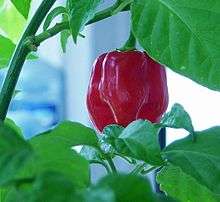
Since the 1980s, spice heat has been assessed quantitatively by high-performance liquid chromatography (HPLC), which measures the concentration of heat-producing capsaicinoids, typically with capsaicin content as the main measure.[4][5] As stated in one review: "the most reliable, rapid, and efficient method to identify and quantify capsaicinoids is HPLC; the results of which can be converted to Scoville Heat Units by multiplying the parts-per-million by 16."[4] HPLC results permit the measurement of a substance’s capsaicin capacity to produce perceived heat ("pungency"). This method gives results in American Spice Trade Association "pungency units", which are defined as one part capsaicin per million parts dried pepper mass.[5]
For parts per million (ppm) measurements, SHU units are calculated from "parts per million of heat" (ppmH), which is found with the following calculation:
Peak areas are calculated from HPLC traces of dry samples of the substance to be tested in 1 ml of acetonitrile. The standard used to calibrate the calculation is 1 gram of capsaicin. Scoville heat units are found by multiplying the ppmH value by a factor of 15 or 16.[4][5]
An orally administered capsule of capsaicinoids claiming 100,000 Scoville units will correspond to around 6.6 mg of capsaicinoids.[14]
The levels of pungency, in terms of Scoville units are:[9]
| Pungency | SHU |
|---|---|
| Very highly pungent | Above 80,000 |
| Highly pungent | 25,000 to 70,000 |
| Moderately pungent | 3,000 to 25,000 |
| Mildly pungent | 700 to 3,000 |
| Non pungent | 0 to 700 |
Scoville ratings
Considerations
Since Scoville ratings are defined per unit of dry mass, comparison of ratings between products having different water content can be misleading. For example, typical fresh chili peppers have a water content around 90%, whereas Tabasco sauce has a water content of 95%.[15] For law-enforcement-grade pepper spray, values from 500,000 up to 5 million SHU have been reported,[1][16] but the actual strength of the spray depends on the dilution.[3]
Numerical results for any specimen vary depending on its cultivation conditions and the uncertainty of the laboratory methods used to assess the capsaicinoid content.[4] Pungency values for any pepper are variable, owing to expected variation within a species, possibly by a factor of 10 or more, depending on seed lineage, climate and humidity, and soil composition supplying nutrients. The inaccuracies described in the measurement methods also contribute to the imprecision of these values.[4][11]
Capsicum peppers
Capsicum chili peppers are commonly used to add pungency in cuisines worldwide.[3][4] The range of pepper heat reflected by a Scoville score is from 100 or less (sweet peppers) to over 3 million (Pepper X) (table below; Scoville scales for individual chili peppers are in the respective linked article).
The chilis with the highest rating on the Scoville scale exceed one million Scoville units, and include specimens of naga jolokia or bhut jolokia and its cultivars, the "Dorset naga" and the "bhut jolokia", neither of which has official cultivar status.[17][18]
Numerical results for any specimen vary depending on its cultivation conditions and the uncertainty of the laboratory methods used to assess the capsaicinoid content. Pungency values for any pepper are variable, owing to expected variation within a species—easily by a factor of 10 or more—depending on seed lineage, climate (humidity is a big factor for the Bhut Jolokia; the Dorset Naga and the original Naga have quite different ratings), and even soil (this is especially true of habaneros). The inaccuracies described in the measurement methods above also contribute to the imprecision of these values. When interpreting Scoville ratings, this should be kept in mind.[11]
The Scoville scale may be extrapolated to express the pungency of substances that are even hotter than pure capsaicin. One such substance is resiniferatoxin, an alkaloid present in the sap of some species of euphorbia plants (spurges). Since it is 1000 times as hot as capsaicin, it would have a Scoville scale rating of 16 billion.[19]
| Scoville heat units | Examples |
|---|---|
| 1,500,000–3,000,000+ | Most law enforcement grade pepper spray,[20][21][lower-alpha 1] Trinidad Moruga Scorpion[22], Pepper X,[23] Carolina Reaper,[24] Dragon's Breath[25] |
| 750,000-1,500,000 | Naga Viper pepper,[26] Infinity Chilli,[27] Bhut Jolokia chili pepper,[28][29] Trinidad Scorpion Butch T pepper,[30] Bedfordshire Super Naga[31] |
| 350,000–750,000 | Red Savina habanero[32], Chocolate habanero[33], Habanaga, Nagabon |
| 100,000–350,000 | Habanero chili,[34] Scotch bonnet pepper,[34] Datil pepper, Rocoto, Piri Piri Ndungu, Madame Jeanette, Peruvian White Habanero,[35] Jamaican hot pepper,[36] Guyana Wiri Wiri, Fatalii [37] |
| 50,000–100,000 | Byadgi chilli, Bird's eye chili (a.k.a.. Thai Chili Pepper),[38] Malagueta pepper,[38] Chiltepin pepper, Piri piri (African bird's eye), Pequin pepper,[38] |
| 25,000–50,000 | Guntur chilli, Cayenne pepper, Ají pepper,[34] Tabasco pepper, Cumari pepper (Capsicum Chinense), Peperoncini, Katara (spicy), Arbol pepper |
| 10,000–25,000 | Serrano pepper, Peter pepper, Aleppo pepper |
| 2,500–10,000 | Espelette pepper, Jalapeño pepper, Chipotle,[34][39] Guajillo pepper, New Mexican varieties of Anaheim pepper,[40] Hungarian wax pepper, Bullet pepper |
| 1,000–2,500 | Anaheim pepper, Poblano pepper, Rocotillo pepper, Peppadew |
| 100–1,000 | Pimento, Banana pepper |
| 0-100 | Bell pepper, Cubanelle, Aji dulce |
Capsaicinoids
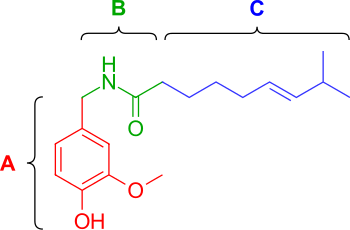
The class of compounds causing pungency in plants such as chili peppers is called capsaicinoids, which display a linear correlation between concentration and Scoville scale, and may vary in content during ripening.[41] Capsaicin is the major capsaicinoid in chili peppers.[5]
| Scoville heat units | Chemical | Ref |
|---|---|---|
| 16,000,000,000 | Resiniferatoxin | [42] |
| 5,300,000,000 | Tinyatoxin | [43] |
| 16,000,000 | Capsaicin | [44][14] |
| 15,000,000 | Dihydrocapsaicin | [44] |
| 9,200,000 | Nonivamide | [44] |
| 9,100,000 | Nordihydrocapsaicin | [44][14] |
| 8,600,000 | Homocapsaicin, Homodihydrocapsaicin | [44] |
| 160,000 | Shogaol | [45] |
| 100,000 to 200,000 | Piperine | [46] |
| 60,000 | Gingerol | [45] |
| 16,000 | Capsiate |
Notes
- The pungency is diluted to 200,000 or fewer SHU.
References
- Barry-Jester, Anna Maria (October 15, 2014). "Rating Chili Peppers On A Scale Of 1 To Oh Dear God I'm On Fire". FiveThirtyEight. Retrieved 2014-11-02.
- "Some Like It Hot: Dorset's Ultra-Hot Chillies". Archived from the original on 19 November 2012. Retrieved 25 August 2010.
- Twilight Greenaway (10 January 2013). "How Hot is That Pepper? How Scientists Measure Spiciness". Smithsonian.com, US Smithsonian Institution. Retrieved 17 December 2017.
- Guzmán, I; Bosland, P. W (2017). "Sensory properties of chili pepper heat - and its importance to food quality and cultural preference". Appetite. 117: 186–190. doi:10.1016/j.appet.2017.06.026. PMID 28662907.
- Collins MD, Wasmund LM, Bosland PW (1995). "Improved method for quantifying capsaicinoids in Capsicum using high-performance liquid chromatography". HortScience. 30 (1): 137–139. doi:10.21273/HORTSCI.30.1.137.
- Peter, KV, ed. (2001), Handbook of Herbs and Spices, 1, CRC Press, p. 120, ISBN 978-0-8493-1217-5
- Mazourek M, Pujar A, Borovsky Y, Paran I, Mueller L, Jahn MM (2009). "A Dynamic Interface for Capsaicinoid Systems Biology" (PDF). Plant Physiology. 150 (4): 1806–1821. doi:10.1104/pp.109.136549. PMC 2719146. PMID 19553373.
- Scoville, Wilbur (May 1912). "Note on Capsicums". Journal of the American Pharmaceutical Association. 1 (5): 453–454. doi:10.1002/jps.3080010520.
- Al Othman, Zeid Abdullah (2011). "Determination of Capsaicin and Dihydrocapsaicin in Capsicum Fruit Samples using High Performance Liquid Chromatography". Molecules: 8920.
- Peter, K. V. (2012). Handbook of Herbs and Spices. Elsevier Science. p. 127. ISBN 978-0-85709-5671.
- Tainter, Donna R.; Anthony T. Grenis (2001). Spices and Seasonings. Wiley-IEEE. p. 30. ISBN 978-0-471-35575-5.
Interlab variation [for the original Scoville scale] could be as high as +/−50%. However, labs that run these procedures could generate reasonably repeatable results.
- Stoica R, Moscovici M, Tomulescu C, Băbeanu N (2016). "Extraction and analytical methods of capsaicinoids - a review" (PDF). Scientific Bulletin. Series F. Biotechnologies. XX: 93–96. ISSN 2285-1364.
- DeWitt, Dave; Bosland, Paul W. (2009). The Complete Chile Pepper Book. ISBN 978-0-88192-920-1.
- O'Keefe, James H.; DiNicolantonio, James J.; McCarty, Mark F. (2015-06-01). "Capsaicin may have important potential for promoting vascular and metabolic health". Open Heart. 2 (1): e000262. doi:10.1136/openhrt-2015-000262. ISSN 2053-3624. PMC 4477151. PMID 26113985.
- USDA nutrient database for Peppers, jalapeño, raw (92% water content); Peppers, hot chile, red, raw (88% water content); Red Tabasco sauce (95%)
- "Chemical hazards in law enforcement". The Police Policy Studies Council. Retrieved 2009-02-09.
Most law enforcement sprays have a pungency of 500,000 to 2 million SHU. One brand has sprays with 5.3 million SHU.
- "World's hottest chilli grown in Grantham, Lincs". The Daily Telegraph. London: Telegraph.co.uk. 2010-04-01. Retrieved 2010-04-24.
- "Grantham firm grows world's hottest chilli". www.thisislincolnshire.co.uk. Retrieved 2010-04-24.
- Atala, Anthony, and Debra Slade (2003), Bladder Disease, (Washington DC: National Bladder Foundation), p. 361.
- "Chemical hazards in law enforcement". The Police Policy Studies Council. Retrieved 2009-02-09.
Most law enforcement sprays have a pungency of 500,000 to 2 million SHU. One brand has sprays with 5.3 million SHU.
- "The Truth About Defensive Spray Heat". Sabre red.
Sabre Red = 10% OC @ 2,000,000 Scoville Heat Units. Thus, 90% of the formulation dilutes the 2,000,000 SHUs creating a Scoville Content of 200,000.
- "Chile experts identify Trinidad Moruga Scorpion as world's hottest". UK: The Daily Telegraph. 2012-02-16.
- Mike Hultquist (23 February 2018). "Pepper X – Latest News and Information". Chili Pepper Madness. Retrieved 21 January 2019.
- Hallock, Betty (December 26, 2013). "World's hottest pepper hits 2.2 million Scoville heat units". Los Angeles Times.
- Shanika Gunaratna (22 May 2017). "The hottest pepper in the world? Beware the 'Dragon's Breath'". CBS news.
- Dykes, Brett Michael (3 December 2010). "World's hottest pepper is 'hot enough to strip paint'". Yahoo! News. Retrieved 3 December 2010.
- "Grantham's Infinity chilli named hottest in world". News. BBC. 2011-02-18.
- Shaline L. Lopez (2007). "NMSU is home to the world's hottest chile pepper". Archived from the original on 2007-02-19. Retrieved 2007-02-21.
- AP (23 February 2007). "World's hottest chili pepper a mouthful for prof". CNN. Archived from the original on 22 March 2007. Retrieved 26 February 2007.
- Matthew Da Silva, "Aussies grow world's hottest chilli" Archived 2011-10-28 at the Wayback Machine, Australian Geographic, 12 April 2011
- "UK's hottest commercially grown chilli pepper goes on sale". Archived from the original on 2016-03-04. Retrieved 2012-09-22.
- "World's hottest chile pepper discovered". American Society for Horticultural Science. Retrieved 2008-03-31.
- "Chile Pepper Heat Scoville Scale". Homecooking.about.com. Retrieved 2013-04-14.
- "Chile Pepper Heat Scoville Scale". About. Retrieved 2006-09-25.
- "Habanero White". Chile man. Retrieved Sep 21, 2011.
- "The Scoville Scale". Happy stove.
- Scoville Food Institute, Periodic Table of Scoville Units.
- "Scoville Scale Chart for Hot Sauce and Hot Peppers". Scott Roberts. Retrieved 2008-11-19.
- Scoville hot sauce heat scale, Hot sauce
- "Anaheim Pepper" (PDF). Chile Pepper Institute at New Mexico State University. 2007. Archived from the original (PDF) on 2008-07-05. Retrieved 2007-10-22.
- Nagy, Z; Daood, H; Ambrózy, Z; Helyes, L (2015). "Determination of Polyphenols, Capsaicinoids, and Vitamin C in New Hybrids of Chili Peppers". Journal of Analytical Methods in Chemistry. 2015: 1–10. doi:10.1155/2015/102125. PMC 4606152. PMID 26495153.
- Ellsworth, Pamela; Wein, Alan J. (2009). Questions and Answers about Overactive Bladder. Jones & Bartlett Learning. pp. 97–100. ISBN 978-1449631130.
- Premkumar, Louis S. (2014-06-13). "Transient Receptor Potential Channels as Targets for Phytochemicals". ACS Chemical Neuroscience. 5 (11): 1117–1130. doi:10.1021/cn500094a. ISSN 1948-7193. PMC 4240255. PMID 24926802.
- Govindarajan, Sathyanarayana (1991). "Capsicum — Production, Technology, Chemistry, and Quality. Part V. Impact on Physiology, Pharmacology, Nutrition, and Metabolism; Structure, Pungency, Pain, and Desensitization Sequences". Critical Reviews in Food Science and Nutrition. 29 (6): 435–474. doi:10.1080/10408399109527536. PMID 2039598.
- Compton, Richard G.; Batchelor-McAuley, Christopher; Ngamchuea, Kamonwad; Chaisiwamongkhol, Korbua (2016-10-31). "Electrochemical detection and quantification of gingerol species in ginger (Zingiber officinale) using multiwalled carbon nanotube modified electrodes". Analyst. 141 (22): 6321–6328. Bibcode:2016Ana...141.6321C. doi:10.1039/C6AN02254E. ISSN 1364-5528. PMID 27774555.
- Mangathayaru, K. (2013). Pharmacognosy: An Indian perspective. Pearson Education India. p. 274. ISBN 9789332520264.
